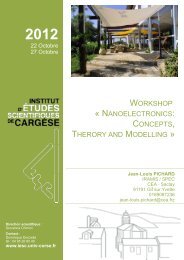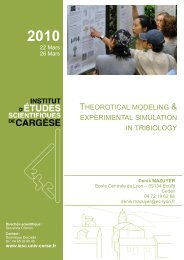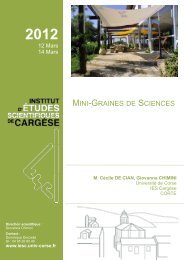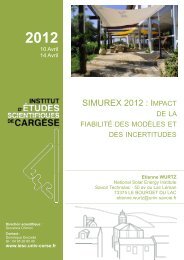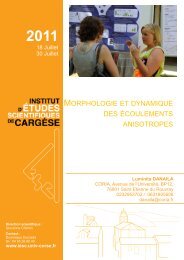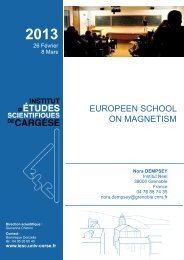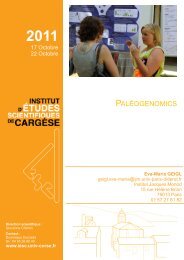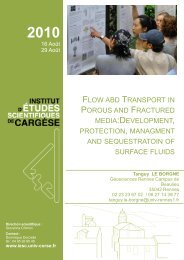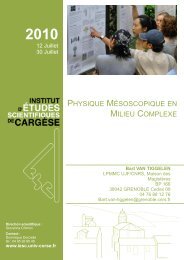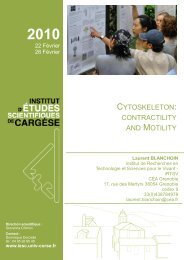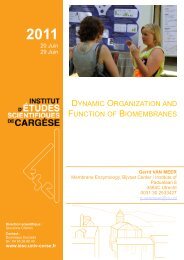Mathias FINK - Institut d'études scientifiques de Cargèse (IESC)
Mathias FINK - Institut d'études scientifiques de Cargèse (IESC)
Mathias FINK - Institut d'études scientifiques de Cargèse (IESC)
You also want an ePaper? Increase the reach of your titles
YUMPU automatically turns print PDFs into web optimized ePapers that Google loves.
Photoacoustic tomography (PAT), combining optical and ultrasonic waves via the photoacoustic<br />
effect, provi<strong>de</strong>s in vivo multiscale non-ionizing functional and molecular imaging. PAT is the only<br />
modality capable of imaging across the length scales of organelles, cells, tissues, and organs with<br />
consistent contrast. PAT has the potential to empower multiscale systems biology and accelerate<br />
translation from microscopic laboratory discoveries to macroscopic clinical practice. PAT may also<br />
hold the key to the earliest <strong>de</strong>tection of cancer by in vivo label-free quantification of<br />
hypermetabolism, the quintessential hallmark of cancer. Time-reversed ultrasonically enco<strong>de</strong>d<br />
(TRUE) optical focusing is based on ultrasonic modulation of coherence light propagating in<br />
scattering tissue followed by time reversal of the ultrasonically enco<strong>de</strong>d light component. TRUE<br />
focusing can noninvasively <strong>de</strong>liver light to a dynamically <strong>de</strong>fined focus <strong>de</strong>ep in a scattering<br />
medium. This technology opens the door to an even greater paradigm-shifting opportunity—one<br />
that controls the photon paths to minimize transmission loss in tissue.<br />
Pr. Martin Wegener<br />
Transformation materials for optics, elastodynamics, and thermodynamics<br />
I review our experimental efforts regarding implementing the i<strong>de</strong>as of transformation optics in the<br />
areas of optics, mechanics, and thermodynamics. This requires <strong>de</strong>signing and fabricating artificial<br />
materials with intentionally spatially inhomogeneous and/or anisotropic effective material<br />
properties. In optics, visible-frequency broadband polarization-in<strong>de</strong>pen<strong>de</strong>nt three-dimensional<br />
carpet cloaks have become possible. In mechanics, broadband two-dimensional free-space cloaks<br />
have been <strong>de</strong>monstrated and pentamo<strong>de</strong> metamaterials for three-dimensional architectures are<br />
emerging. In thermodynamics, two-dimensional free-space cloaks have recently become possible -<br />
bringing us back to the beginnings of the field, i.e., to the Cal<strong>de</strong>ron tomography problem.<br />
Pr. Nikolay Zhelu<strong>de</strong>v<br />
What’s matter with meta matter ?<br />
We report on recent <strong>de</strong>velopments in metamaterials and nanophotonics research. Out particular<br />
focus will be on coherent control of signals with metamaterials, generation of vector potential fields<br />
with toroidal structures and using photonic network as oracle for solving complex <strong>de</strong>cision<br />
problems.<br />
Pr. Clau<strong>de</strong> Boccara<br />
Random behavior in optical coherence<br />
The randomness of the refractive in<strong>de</strong>x and/or the position of the scatterers blur the images in<br />
biological tissues. OCT by selecting singly backscattered photons is a first approach that allows<br />
overcoming this problem. Even with incoherent sources the OCT signal exhibits a speckle<br />
distribution. Despite of the speckle in the images the Full Field OCT (FFOCT) approach that we<br />
have <strong>de</strong>veloped allows to reveal the tissue morphology at the micron scale and starts to be a<br />
valuable tool in intra operative surgery. Sometimes the morphology is not enough to characterize<br />
the tissue, so we will examine the basic nature of the signal and what kind of supplementary<br />
information can be extracted from the OCT data such as local refractive in<strong>de</strong>x, <strong>de</strong>nsity of scatterers<br />
and elasticity map. Finally (because we are in Cargese !) I will shows how FFOCT is used to count<br />
and characterize, through their Brownian trajectories, viruses in see water.<br />
Pr. Rémi Carminati<br />
Weak and strong coupling regimes of light-matter interaction in nanoscale disor<strong>de</strong>red media<br />
The interplay between multiple scattering, near-field interactions and material resonances in



